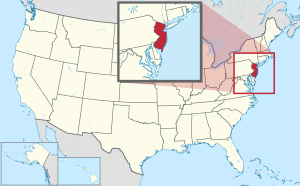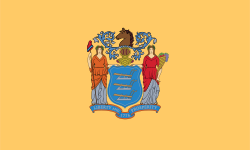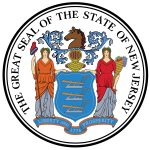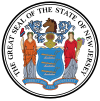New Jersey
New Jersey is one of the 50 states of the United States of America. It is in the northeastern section of the country along the coast of the Atlantic Ocean. It is a geographically small state, shaped like a letter [S], and bordered on the west by Pennsylvania and Delaware across the Delaware River, on the north by New York, on the northeast by the Hudson River and New York City, on the east and southeast by the Atlantic Ocean, and on the southwest by Delaware Bay.
New Jersey | |
|---|---|
| State of New Jersey | |
| Nickname: The Garden State[1] | |
| Motto(s): Liberty and prosperity | |
| Anthem: Hail, New Netherland | |
 Map of the United States with New Jersey highlighted | |
| Country | United States |
| Before statehood | Province of New Jersey |
| Admitted to the Union | December 18, 1787 (3rd) |
| Capital | Trenton |
| Largest city | Newark |
| Largest metro and urban areas | Greater New York |
| Government | |
| • Governor | Phil Murphy (D) |
| • Lieutenant Governor | Tahesha Way (D) |
| Legislature | New Jersey Legislature |
| • Upper house | Senate |
| • Lower house | General Assembly |
| U.S. senators | Bob Menendez (D) Cory Booker (D) |
| U.S. House delegation | 10 Democrats 2 Republicans (list) |
| Area | |
| • Total | 8,722.58 sq mi (22,591.38 km2) |
| • Land | 7,354.22 sq mi (19,047.34 km2) |
| • Water | 1,368.36 sq mi (3,544.04 km2) 15.7% |
| • Rank | 47th |
| Dimensions | |
| • Length | 170 mi (273 km) |
| • Width | 70 mi (112 km) |
| Elevation | 250 ft (80 m) |
| Highest elevation | 1,803 ft (549.6 m) |
| Lowest elevation (Atlantic Ocean[2]) | 0 ft (0 m) |
| Population (2023) | |
| • Total | 13,082,190 |
| • Rank | 13th |
| • Density | 1,210.10/sq mi (700/km2) |
| • Rank | 1st |
| • Median household income | $79,363 |
| • Income rank | 3rd |
| Demonym(s) | New Jerseyan (official),[4] New Jerseyite[5][6] |
| Language | |
| • Official language | English |
| • Spoken language | |
| Time zone | UTC−05:00 (Eastern) |
| • Summer (DST) | UTC−04:00 (EDT) |
| USPS abbreviation | NJ |
| ISO 3166 code | US-NJ |
| Traditional abbreviation | N.J. |
| Latitude | 38°56′ N to 41°21′ N |
| Longitude | 73°54′ W to 75°34′ W |
| Website | nj |
| New Jersey state symbols | |
|---|---|
 | |
 | |
| Living insignia | |
| Bird | Eastern goldfinch[8] |
| Fish | Brook trout[9] |
| Flower | Viola sororia |
| Insect | Western honey bee |
| Mammal | Horse |
| Tree | Quercus rubra (northern red oak),[10] dogwood (memorial tree) |
| Inanimate insignia | |
| Colors | Buff and blue |
| Folk dance | Square dance |
| Food | Blueberry (state fruit) |
| Fossil | Hadrosaurus foulkii |
| Soil | Downer[11] |
| State route marker | |
 | |
| State quarter | |
 Released in 1999 | |
| Lists of United States state symbols | |
The capital of New Jersey is Trenton and the largest city is Newark, though New Jersey is better known for bordering the large cities of New York City and Philadelphia. The state nickname is "The Garden State". The current governor is Phil Murphy.[12]
New Jersey is the fourth smallest state, but has the eleventh highest number of people. It therefore has the highest population density (number of people for the amount of land) in the United States. New Jersey is also well known for its beaches,[13] industries, swamps, and pine forests.
The climate is hot and humid summers and cold winters, with about 47 in (1,200 mm) of precipitation every year. The average temperature in the summer is between 82 °F (28 °C) and 87 °F (31 °C), and in winter around 16 °F (-9 °C) to 34 °F (1 °C).[14]
History
Before Europeans came, the land that is now New Jersey was inhabited by the Lenape (also known as Delaware Indians by the English), who were nomads, hunters, and farmers. The Dutch came to the northern area of the state in the 1630s, after Henry Hudson explored the area, thought it was a nice place, and claimed it for the Dutch. Towns quickly sprang up, occupied by the Dutch, Swedes, and Finns. People rushed in. The first towns, such as Bergen (now Jersey City), Trenton (the capitol), and Burlington developed. Many others started themselves upon the west bank of the Hudson. New Jersey was part of the area known at this time as New Netherland.
In 1664, the English took New Netherland from the Dutch and added it to their colonies. This part was renamed New Jersey after an island in the English Channel known as Jersey.
New Jersey took part in the American Revolutionary War, and was a scene of battles. On Christmas in 1776, George Washington's army entered New Jersey to attack British soldiers at Trenton and Princeton. The American army won, in two small but famous battles that were important in boosting American morale.
Later, the rebels drove the British residents out of Princeton and for a time established a national capital there. New Jersey was the third state to join the US and the first to approve the Bill of Rights.
Counties
New Jersey has 21 counties:
| County | FIPS Code | County Seat [15] | Created [15] | Formed from [16] | Named for [17] | Population (2005) [15] | Area [15] | Map |
| Atlantic County | 001 | Mays Landing | 1837 | Gloucester County | The Atlantic Ocean, which forms the county's eastern border | 271,015 | 671 sq mi (1,738 km2) |  |
| Bergen County | 003 | Hackensack | 1675 | One of four original counties created in East Jersey | The town of Bergen op Zoom, Holland or Bergen, Norway | 904,037 | 247 sq mi (640 km2) |  |
| Burlington County | 005 | Mount Holly Township | 1681 | One of two original counties created in West Jersey | The old name for the ancient market town a mile from shore in Bridlington, England | 450,743 | 819 sq mi (2,121 km2) |  |
| Camden County | 007 | Camden | 1844 | Gloucester County | Charles Pratt, 1st Earl Camden (1714–1794), an English supporter of the colonial cause during the American Revolution[18] | 517,001 | 228 sq mi (591 km2) |  |
| Cape May County | 009 | Cape May Court House | 1685 | Burlington County | The 17th-century Dutch explorer Cornelius Jacobsen Mey (?–16??), who explored and surveyed the Delaware Bay to the south of the county | 99,286 | 365 sq mi (945 km2) |  |
| Cumberland County | 011 | Bridgeton | 1748 | Salem County | Prince William, Duke of Cumberland (1721–1765), second son of George II of England and military victor at the Battle of Culloden in 1746 | 154,823 | 677 sq mi (1,753 km2) |  |
| Essex County | 013 | Newark | 1675 | One of four original counties created in East Jersey | The county of Essex in England | 786,147 | 130 sq mi (337 km2) |  |
| Gloucester County | 015 | Woodbury | 1686 | Burlington County | The city of Gloucester, England | 276,910 | 337 sq mi (873 km2) |  |
| Hudson County | 017 | Jersey City | 1840 | Bergen County | The English explorer Henry Hudson (1570–1611), who explored portions of New Jersey's coastline | 601,146 | 62 sq mi (161 km2) |  |
| Hunterdon County | 019 | Flemington | 1714 | Burlington County | Robert Hunter (1664–1734), the Colonial Governor of New Jersey from 1710 to 1720 | 130,404 | 438 sq mi (1,134 km2) |  |
| Mercer County | 021 | Trenton | 1838 | Burlington County, Hunterdon County, Middlesex County, and Somerset County | The Continental Army General Hugh Mercer (1726–1777), who died at the Battle of Princeton[19] | 367,605 | 229 sq mi (593 km2) |  |
| Middlesex County | 023 | New Brunswick | 1675 | One of four original counties created in East Jersey | The former county of Middlesex in England | 789,516 | 323 sq mi (837 km2) |  |
| Monmouth County | 025 | Freehold Borough | 1675 | One of four original counties created in East Jersey | The Rhode Island Monmouth Society or the historic county of Monmouthshire in Wales. | 635,285 | 665 sq mi (1,722 km2) |  |
| Morris County | 027 | Morristown | 1739 | Hunterdon County | Colonel Lewis Morris (1671–1746), colonial governor of New Jersey at the time of the county's formation.[20][21] | 493,160 | 481 sq mi (1,246 km2) |  |
| Ocean County | 029 | Toms River | 1850 | Monmouth County | The Atlantic Ocean, which forms the eastern border of New Jersey | 562,335 | 916 sq mi (2,372 km2) |  |
| Passaic County | 031 | Paterson | 1837 | Bergen County and Essex County | "Pasaeck", a Lenape word meaning "valley" | 499,060 | 197 sq mi (510 km2) |  |
| Salem County | 033 | Salem | 1681 | One of two original counties created in West Jersey | A Hebrew word meaning "peace" | 66,595 | 373 sq mi (966 km2) |  |
| Somerset County | 035 | Somerville | 1688 | Middlesex County | The county of Somerset in England | 319,900 | 305 sq mi (790 km2) |  |
| Sussex County | 037 | Newton | 1753 | Morris County | The county of Sussex in England | 153,384 | 536 sq mi (1,388 km2) |  |
| Union County | 039 | Elizabeth | 1857 | Essex County | The union of the United States threatened by dispute between North and South over slavery | 531,088 | 105 sq mi (272 km2) |  |
| Warren County | 041 | Belvidere | 1824 | Sussex County | The American Revolutionary War General Joseph Warren (1741–1775), killed at the Battle of Bunker Hill | 110,376 | 363 sq mi (940 km2) |  |
References


